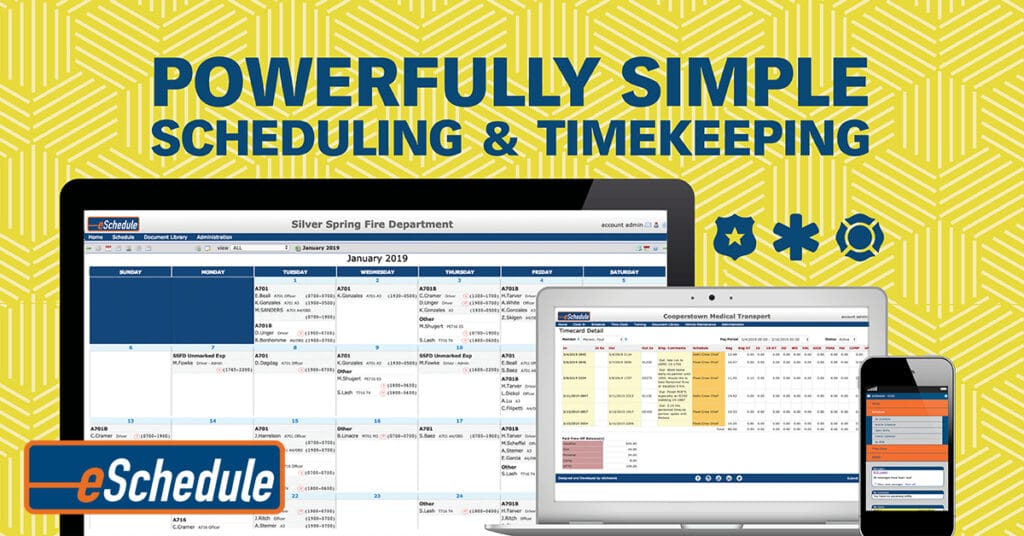
Things have come a long way from when EMS agencies used to schedule on a white board, on paper or even in an Excel file. Today, EMS agencies are understanding the need to automate and improve processes such as scheduling and time and attendance. With so many different options for EMS online scheduling to choose from, it’s hard to know which solution serves as the best fit for your department. Here are 10 features that will maximize the ROI and overall experience for any size EMS organization.
Automated E-Mails & Text Alerts
Being able to automatically notify employees or volunteers of open shifts and schedule changes is one of the most common uses for an EMS scheduling software. The software should be able to automatically push out notifications to employees. Modern scheduling systems are also able to send alerts and messages of new company policies that can be enforced by requiring an employee to acknowledge the message before being allowed to use the system again.
Mobile-Friendly
EMTs and paramedics are almost always “on the go”. When your employees need to know the information in the field, they rely on their smartphone or tablet. Trying to use an unresponsive or outdated software system on a mobile device can lead to annoyance and frustration resulting in critical information not being received. Making sure the online scheduling system provides mobile-optimized access for both users, as well as managers, is a necessity in today’s world.
Employee Shift Swaps / Trades
Automated shift swapping (trading) is another essential feature to look for when choosing an EMS scheduling platform. This is one of the biggest time-saving features in an automated scheduling tool because it allows organizations to use the software to let employees find their own coverage or enter a swap request with another employee. Rather than the previous manual approval process, schedulers can now simply receive an alert to approve a new shift swap.
Qualified Shift Roles/Positions
Your online scheduling platform should also be able to differentiate positions or roles (e.g. Paramedic, EMT, Driver, Trainee) based on the current certifications and licenses that each employee holds. By creating a schedule based on qualified workers on a shift, you are ensuring that an ambulance is staffed correctly and can provide an adequate level of service based on your organization’s policies. Some shifts or vehicles may require different staff qualifications or more than the standard number of staff. Because of this, choosing a scheduling software that gives you the ability to assign multiple job or role qualifications to a user is essential to an EMS environment.
Schedule Change Audit
An upgraded EMS Scheduling Software will also ensure that all changes to shifts or schedules including when the change was made and who made it are logged. This is extremely important when it comes to investigating any type of scheduling discrepancy that may have occurred.
Reporting
An EMS scheduling tool should provide agencies with the insights needed to increase productivity and reduce costs. In order to best manage your schedule and organization, you must have real-time access to reports, allowing you to gain access to specific data that is important to you. Some common reports to analyze include training records, scheduling, timekeeping, and a payroll export report.
Multiple User Login Access Levels
EMS agencies are open and responding to calls 24/7, it is important that every supervisor responsible for scheduling has access to the EMS scheduling platform. Access levels allow all responsible personnel to gain access to the software, while still being managed through permission-based settings.
Overtime Tracking & Rest Periods
A scheduling system should allow agencies to set rules and thresholds for a maximum number of hours an employee should be scheduled for and warn managers when employees are set into overtime hours. In addition, all EMS scheduling software should have a safety feature built in that allows agencies to set a minimum number of hours between shifts that an employee can be scheduled for, ensuring that employees have enough time off between shifts to rest and recharge.
Training Record Integration
This feature should allow organizations to store records of all employees’ certification records, and send notifications to the employee when a certification is about to expire. An optimized EMS scheduling software will give agencies the ability to upload, store, and approve new certifications through the system.
Timekeeping & Payroll Integration
The final key feature to look for in an EMS scheduling software is integration with your time clock software and current payroll system. The scheduling system should give your agency the option to integrate with your current payroll company or software. This feature alone can greatly decrease the amount of time needed to make manual entries or adjustments.
eSchedule — EMS Scheduling Software
Since 2004, eSchedule has worked with hundreds for EMS agencies to improve their scheduling and time clock processes. We have everything an EMS operation needs from automated employee scheduling to sick call-out management and schedule change notification.
If you are in the EMS industry and need a scheduling software that works for you, complete this short form and we’ll be in touch with more information.
